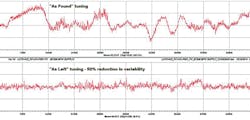"The delayed coking unit in a refinery is complex due to its semi-continuous nature and process severity," says Eric Wheatcroft, process control engineer at CHS Inc. "There are also significant reoccurring process disturbances, which make controlling a coker extremely challenging."
To minimize the process disturbances from coke drum switches, improve distillate yield from the fractionator, and decrease operator intervention, CHS recently teamed with Emerson Process Management to develop and implement new strategies and methods for evaluating the coker unit's performance and implement advanced process control (APC) that calmed the coker and produced significant return on investment.
[javascriptSnippet]
Wheatcroft and James Beall, principal process control consultant at Emerson, together with John Ward, refining business development manager at Emerson, will present details of the CHS project in session 3-5080, "Achieving Operational Excellence on a Semi-Continuous Process: A DeltaV APC Project" at 8:00 a.m. on Tuesday in Room 304, and again at 4:15 p.m. on Thursday in Room 710 at Emerson Exchange.
At its root, delayed coking is an endothermic process with vacuum residuals rapidly heated and contained in a coke drum. Wheatcroft reports CHS's application has three separate steps, including partial vaporization and mild cracking of feed in furnace; cracking of vapors as flow passes through the coke drum; and successive cracking and polymerization of hydrocarbons in the coke drum. "Yields and product quality are a function of temperature, pressure, and throughput ratio, and so increases in coking temperature decrease coke production and increase hydrocarbon yield," says Wheatcroft.
These before and after trendlines show how CHS used advanced process controls from Emerson Process Management to calm a refinery coker's wandering processes.
Unfortunately, delayed coking also entails a host of unmeasured and unqualified disturbances, such as during back-warming and in drum switches. Many disturbances also occur in heavy coker gas oil (HCGO) pall filter switches when HCGO pump-around is integrated into the product circuit, amplifying the effects of hourly pall filter switches. "Control also induces variability, such as when feed-pump spillback affects a pressure-control valve or when tower reflux affects a control valve," adds Wheatcroft. "What would you do if your fractionator is in equilibrium and the vapor/liquid (V/L) feed rate, feed composition and heat input suddenly changed by 20-30%?"
"We needed to analyze key control loops, not just tune loops," explains Wheatcroft. "Our goal was to improve process performance, not just loop performance. So, we reviewed control metrics with DeltaV InSight, and reviewed our control configuration and scheme to maximize process performance. Besides performing field walk-downs and assessments, and conducting operator interviews to better understanding the coking process and problems, CHS and Emerson determined the scope of the APC project by reviewing and analyzing 30 key loops. They found issues with three instruments and two critical valves; identified tuning changes on 27 of 30 loops; and recommended a new control scheme for critical equipment.
As a result, CHS's new APC implementation reduced variability by more than 30% on 10 of the 30 loops; increased waste-heat recovery (saving $70,000 per year); and identified critical valves requiring maintenance. "We also reduced the time required to implement APC, and increased the benefit of APC projects by coordinating control-loop responses," adds Wheatstone. "These provided 25-50% of the total APC project's benefits.
"We eliminated operator intervention during coke drum back-warm and drum-switch operations. Average LCGO production was increased by almost 5% of rate, which resulted in project payback of six months. We also reduced downstream unit constraints by shifting HCGO production to LCGO. Finally, our management and operators gained confidence in advanced control."
Of course, the preceding highlights just scratch the surface of CHS and Emerson's APC project. For more details on their assessment and implementation process, the best plan is to attend the session itself.
While there's much expertise to be gained through the many workshops and networking opportunities during Exchange week, the Educational Services arm of Emerson Process Management has stepped up to offer a record number of courses this week in Denver. These four-hour sessions normally cost anywhere from $475 to $700, but are available free to registered Exchange attendees.
Twenty different process control and instrumentation courses are on offer in 38 sessions Tuesday and Wednesday morning and afternoon. "The classes span eight of our 13 business units, from valve sizing and specification to DeltaV virtualization," says Bill Wyre, global marketing and business development manager, Educational Services, for Emerson Process Management. "We have nearly 800 seats to fill, and we hope that as many users as possible will take advantage of this opportunity to elevate their technical expertise."
Each of the classes earn attendees 0.4 continuing education units (CEUs). Sign up on line through the MyExchange tool, or stop by the registration desk to reserve a spot. The full course line-up also can be viewed in the Exchange app; filter session type by Educational Services Courses.








